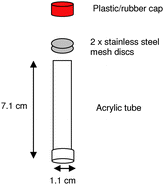A few studies have suggested that the precision and accuracy of measurement of NO2 by Palmes-type passive diffusion tube (PDT) are affected by the method of preparation of the triethanolamine (TEA) absorbent coating on the grids. Theses studies have been quite limited in extent and have tended to evaluate PDT accuracy as zero bias between PDT NO2 value and the exposure-averaged NO2 determined by co-located chemiluminescence analyser. This ignores the well-documented intrinsic systematic biases on PDT-derived NO2, such as within-tube chemistry and exposure-duration nitrite loss, which may lead to non-zero bias values irrespective of effects of TEA absorbent preparation method on PDT accuracy. This paper reports on a statistical analysis of a large dataset comprising 680 duplicated PDT exposures spanning 146 separate exposure periods, spread over five urban exposure locations and a number of years. In each exposure period, PDTs prepared by between four and six different grid preparation methods were simultaneously compared. The preparation methods used combinations of the following: acetone or water as the TEA solvent; 20% or 50% as %TEA in the solution; and application of TEA solution by dipping grids for several minutes in the solution before drying and tube assembly, or by pipetting 50 µL of solution directly onto grids already placed in the PDT cap. These represent the range of preparation procedures typically used. Accuracy was evaluated as maximised nitrite capture within an exposure. Data were analysed by general linear modelling including examination of interaction between different aspects of grid preparation method. PDT precision and accuracy were both significantly better, on average, when the PDT grids were prepared by dipping in TEA solution, and neither solvent or %TEA used for the dipping solution were important. Where PDT preparation by pipetting TEA solution onto grids is to be used, better performance was obtained using 20% TEA in water. A systematic positive bias in PDT measure of NO2, consistent with within-tube oxidation of NO to NO2 and independent of preparation method, was again evident in this work.

You have access to this article
 Please wait while we load your content...
Something went wrong. Try again?
Please wait while we load your content...
Something went wrong. Try again?


 Please wait while we load your content...
Please wait while we load your content...